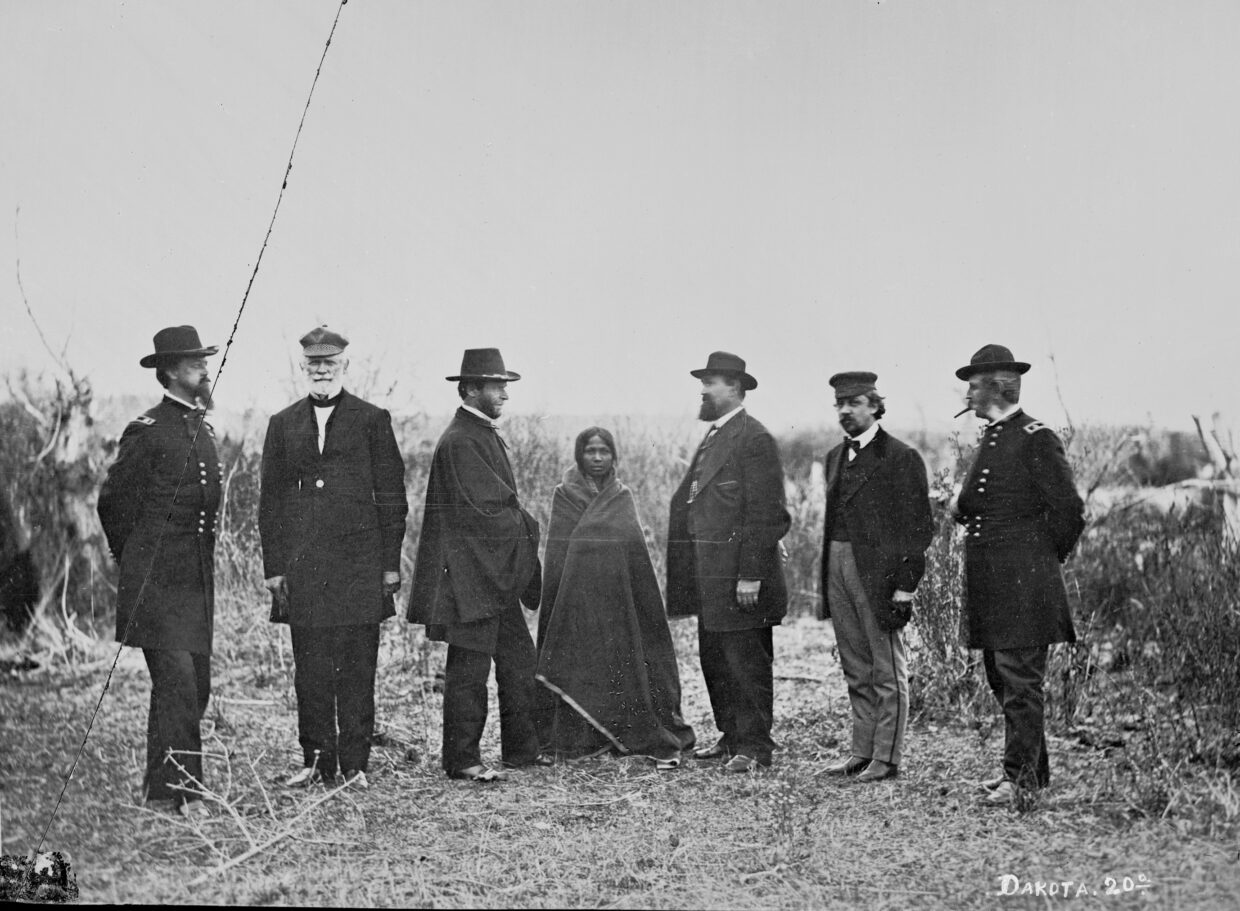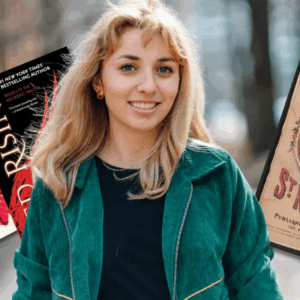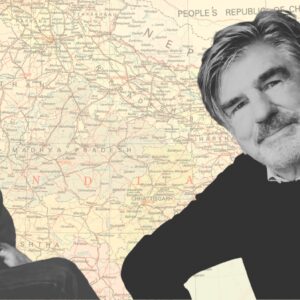
What a 19th-Century Photograph Reveals About Power, Privilege and Violence in the American West
Martha A. Sandweiss Unearths the Hidden History Behind a Moment of Westward Expansion Preserved for Posterity
The girl in the middle demands our attention.
She looks straight at the camera, wrapped tight in a trade blanket that conceals her body. Six white men in military and civilian garb crowd her space, standing to either side of her, symmetrically framing her in the center. None of them look at her or acknowledge her presence, neither with a glance nor a reassuring hand.
Who is she? Why is she there?
Like most collectors of nineteenth-century photographs, I think about why the pictures were made. I think about who made them and who saw them. I wonder how they ended up in the flea market or archive where they caught my eye. But I am also a historian, and I began to wonder whether I could identify unnamed subjects in some of the more well-known photographs that document the American Civil War and the nation’s westward expansion. Might I be able to name that gold miner, that railroad worker, or one of those Union or Confederate soldiers lying in the fields at Antietam? (The Civil War buffs quickly convinced me that if it were possible to identify those soldiers, it would have been done long ago, and by people far more expert in military dress than I.) I imagined writing about a handful of old pictures, exploring how their meanings shift when we learn who the subjects are.
The photograph invites us to wonder about the photographer and his subjects, to speculate about their lives beyond this staged moment on a hard-packed patch of earth.
The work proved harder than anticipated. It took me a long time to figure out the identity of the child in one of Alexander Gardner’s western photographs. But then, with her name in hand, I found her story—buried deep in legal files, memoirs, government records, and fading family memories. I soon realized I did not need more photographs; one was enough.
Gardner made the picture in early May 1868, at Fort Laramie, a remote military outpost in Dakota Territory along an overland trail. He was there to photograph the members of a federal Indian Peace Commission and the tribes of the northern plains with whom they hoped to negotiate a treaty.
His picture of six commissioners and the unnamed child documents a pause amid weeks of intense diplomatic talks. The composition is formal and stiff, notable mainly for the presence of the unidentified girl. But the photograph invites us to wonder about the photographer and his subjects, to speculate about their lives beyond this staged moment on a hard-packed patch of earth. All of them, it turns out, have personal connections to the bigger events roiling the United States—slavery and its defeat, the Civil War, westward expansion, and the military and political assault on Native nations. All have complex family lives. And all have a deep familiarity with violence: the intimate sort inflicted behind closed doors, and the military sort unfolding in plain sight; the violence executed with guns and fists, and the violence enabled by legislative acts and legal rulings. Their lives make manifest the endemic violence of American life—violence sometimes hard to see because it is everywhere.
The photographer captured a fleeting second of time. He could not see where his subjects came from. He could not know where they would end up. We can. We’ll watch as they wander into the photograph, then walk off into the rest of their lives.
Several copies of the photograph survive, each affixed to a stiff 14-by-19½- inch cardboard mount preprinted with an ornate border, Gardner’s name and studio address, and a title rendered in heavy Gothic type: Scenes in the Indian Country. Across the bottom, Gardner identifies his subjects in pencil: General Alfred Howe Terry, General William S. Harney, General William Tecumseh Sherman, General John B. Sanborn, Colonel Samuel F. Tappan, and General Christopher C. Augur. But he gives the girl no name, identifying her only as “Arappaho.” Later, before he deposited his negative in a Washington, DC, archive, he changed his mind. On the glass plate itself, he—or perhaps an assistant—inscribed the word “Dakota.” At some point, the glass negative cracked, and a thin black lightning strike of a line smote General Terry in the chest.
A deep anxiety about the place of Native peoples in an expanding American nation had brought the men west. Armed conflict on the northern plains increased from the 1850s into the 1860s as white settlers crossed deep into Indian Country, claiming the land and natural resources of Native nations. The American military sided with the westering immigrants, and later, the railroads as they snaked their way west. Small skirmishes between white travelers and aggrieved Indians escalated into larger conflicts. In response to a new outbreak of violence in the mid-1860s, Congress organized the Peace Commission in July 1867 to “establish peace with certain hostile Indian tribes” and “remove the causes of war,” secure the frontier settlements and railroad lines, and come up with a plan for “civilizing” the Indians. The commissioners at Fort Laramie—a calculated mix of military men and Indian rights activists—hoped to make the Lakotas accept a Great Sioux Reservation and to push the Northern Arapahos, Crows, and Northern Cheyennes onto reservations as well. There, the commissioners hoped, the Native peoples of the northern plains would embark on the path toward cultural assimilation.
The year before, at Medicine Lodge, Kansas, the commissioners had persuaded the southern tribes to accept reservations in Indian Territory. If they could induce these other tribes to move to reservations north of the North Platte River, a wide swath of land across Kansas and Nebraska would be safe from Indian threats. Then, as poet Walt Whitman put it, the transcontinental railroad tracks “with iron interlaced” could knit east and west together into the seamless fabric of a post-Civil War nation.
The photograph—one of a series of some 52 large and 101 smaller stereo views Gardner made around the fort—appears as a seemingly self-explanatory illustration in books about the Indian Wars. Yet like most nineteenth-century photographs, it both invites us in and resists our understanding. On the one hand, it spurs our historical empathy. Squint hard, use a little imagination, and you can feel the midday sun on the girl’s bare head and sense the men’s restlessness. On the other hand, the photograph explains little, including why the child is there.
French historian Emmanuel Le Roy Ladurie once said there are two kinds of historians: parachutists and truffle hunters. The parachutist, observing broad patterns and movements across vast stretches of space and time, might glance at Gardner’s photo and see a handful of white men deep in Indian Country. A more detail-focused truffle hunter can’t help but ask who they are, who they had dinner with, and who shared their bed.
Let me confess: by temperament, I am a truffle hunter. I don’t stalk my prey out in the woods with a well-trained pig. I do my hunting in archives and, increasingly, in the digital databases to be found online.
The men in Gardner’s picture are all well-known political or military figures, with their identities on the photographic print easily confirmed by other sources. Most of them knew one another before they became peace commissioners, and many of them knew Gardner. During the second half of the nineteenth century, politics and military service often made a large nation feel like a small world, as white men in power repeatedly crossed paths in Washington, DC, on Civil War battlefields, and at frontier forts. At Fort Laramie, some of the commissioners also ran into familiar Native adversaries, encountered over years of military conflict. Some even recognized the girl and her parents.
That girl, however, remains nameless, both on Gardner’s negative and his prints. Historical actors get lost when they live beyond the reach of record keepers. They get lost when historians focus on the people who hold political power rather than the people who adopt children or get abused by a spouse. They get lost when they are women or children, African American or Native, excluded by law or custom from full participation in American life.

My search for the girl’s identity led me not just to her and her family but also to the women and children connected to the men who stand beside her: an orphaned Indian child adopted and sent back east, a famous mesmerist channeling the spirits of the dead, and an enslaved woman murdered by an enraged master. The search introduced me to a bilingual juggler in a Wild West show, an Irish teamster carting a scalped body, an ambitious Lakota lawyer, an angry wife who flees to Paris, and an angry husband who kills his wife in a Wyoming restaurant. The men in this photograph look different when we put them back into conversation with the people with whom they lived, talked, and fought. We may know them through their public deeds, but they also have private lives. We need to follow them home.
The picture invites us to think about eight people: the six peace commissioners, the unnamed child, and the photographer who captured them standing together. But this book gives particular attention to three. It explores how Alexander Gardner, a Scottish immigrant, learned photography and later found himself witness to a treaty council at a frontier fort. It asks how General William S. Harney acquired the brash self-confidence and violent streak that made the Native peoples gathered at Fort Laramie both fear and admire him. And it looks at the unnamed girl, asking just who she is and why she is there, standing calmly among those tall men.
History has treated each of these three figures differently. Gardner gets lauded as the prolific photographer who helps us see some of the seminal events of American history. Harney is the accomplished soldier. The unnamed child slips by unnoticed. But with a focus on the photograph, it becomes possible to rewrite these stories. Gardner’s work explains less about him than scholars have long imagined. Harney has a disturbing private life. The child has an extraordinary story that takes us straight into the changes reconfiguring Indian Country as a period of warfare rolled into the twentieth century.
With a focus on these three figures, the world hinted at in the photograph—a world of political diplomacy and military decorum— becomes a messier and more interesting place. The photograph was made in the Far West, a place that bore the burden of Americans’ dreams for a national rebirth in the immediate aftermath of the Civil War. In a country riven by deep inequalities, however, opportunity for some came at a loss for others. In a nation wracked by violence, some people became perpetrators, and others victims.
Gardner is our guide to the past. It’s his photograph. But we can use his photograph to understand history in ways he could never have imagined.
It seems counterintuitive. Gardner knew his subjects. He knew the sounds of their voices and could gauge their moods as he eyed their shifting expressions. We, however, can know them differently and perhaps even better. We can’t talk to them, smell their dirty clothes, or hear their muttered complaints. Yet unlike Gardner, we can travel with them through time, glimpsing them before and after they posed for the cameraman. We can know them not through physical proximity but instead through the traces they leave in the paper records.
The oldest person in this photograph was born in 1800, before Meriwether Lewis and William Clark ventured west. The youngest, born sixty years later, lived until 1936, into the heart of the Great Depression. The Civil War, Reconstruction, and Indian Wars sit at the heart of this photograph, but these subjects embody nearly a century and a half of American history, stretching from John Adams to Franklin Roosevelt. As they walk into this photograph and back out again, their stories collide.
It was tedious and difficult to make a photograph in 1868. The wet-plate or collodion process that Gardner used had been around since 1851, and Gardner had mastered the technology. Still, experience did not make the wet-plate process easy, especially outdoors. Consider the sheer quantity of material to transport: the polished glass of various sizes, stored in slotted dustproof boxes; the toxic chemicals, measuring cups, funnels, and trays; the large, heavy view cameras, lenses, and tripods; and the portable dark tent that would be set up in the field to keep out the light. In places without clean water, photographers had to transport their own. Then came the challenge of preparing the plates. It couldn’t be done in advance. Wet-plate negatives retained their sensitivity to light only while wet. Hence the name of the process. A photographer had about fifteen minutes to prepare, expose, and develop a negative before it dried.
The work was hard in a studio and harder still outside. Every splash of rain, speck of dust, or pinprick of light could mar the negative. The photographer’s own warm breath could cloud the image. Gardner carted his supplies to this featureless patch of earth near the fort, set up his tripods and cameras, and then arranged his dark tent nearby, out of sight of the camera’s lens. It was midday; the even light cast no shadows. Ducking inside the darkened space, Gardner selected a piece of glass the proper size for his large camera, cleaned it, and then coated it with collodion, a thick, viscous (and highly combustible) mixture of guncotton in sulfuric ether and alcohol, to which he added a bromide and iodide.
Carefully balancing the plate on his hand, Gardner gently rotated it so the collodion flowed evenly across the surface, from edge to edge. Then as he dipped the plate for several minutes in a bath of silver nitrate, the sticky collodion acted to bind the light-sensitive silver salts to the glass. Finally, Gardner could load the negative in a light-tight plateholder. If the conditions were favorable, he could also coat and sensitize a sheet of glass for his smaller stereo camera, and likewise load that in a plateholder before stepping outside to walk toward his cameras.
Gardner’s two cameras stood side by side on a flat piece of earth strewn with the grazed stubble of last year’s grass. With the larger camera, he would make images for his government employers and the peace commissioners themselves. His smaller, double-lensed stereo camera would produce two not-quite-identical images on a four-by-ten-inch glass plate that could later be printed, cut apart, and mounted as stereographs. Studied through a special handheld viewer, the side-by-side stereo images gave the illusion of three-dimensional reality.
Imagine the photograph as a drop of water. To better understand the past, we need to make that droplet part of a running stream; we need to make time flow.
Gardner understood the limits of his medium. It was visual. No photograph could catch the smell drifting from the nearby military barracks and Indian camps; capture the murmured swirl of French, English, Arapaho, and Lakota; or let a viewer feel the colliding anxieties and expectations that hung heavy over negotiations like this. It was monochrome. No wet-plate photograph could capture the color of the northern plains in spring. Most critically, a photograph could capture only a split second of time.
Gardner’s subjects would have milled around while he ducked inside his dark tent to coat his plates. The men had business to discuss, though not with the child. Who invited her here? Maybe it was Gardner, her father, or one of the commissioners who had taken a shine to her. When Gardner emerged from his tent, plateholder in hand, he would have delivered instructions in his Scottish brogue, directing her and the men how to stand. Then because the slow exposure times of the wet-plate process required everyone to stand stock-still for a second or so, each of his subjects became a knowing collaborator.
The six commissioners stand in a gentle arc on either side of the girl. Gardner orchestrates the scene; placing the girl in the center, then asking her, or perhaps even demonstrating, how to wrap the blanket around her body so her hands are concealed. He asks her to stand on a small box to elevate her a bit. We can’t see it, but it explains why her legs look improbably long. Gardner then directs the men to her sides and tells them where to look. The two men on the ends gaze toward one another, their arms held behind their backs. Next to them, two men face out toward the photographer. The commissioners flanking the girl, who barely reaches their shoulders, face one another over her head. The men look humorless. The child—who has never been photographed before—heeds the photographer’s injunction to look straight ahead.
Gardner could envision what it would all look like when his camera translated the living color of the scene into a monochrome image. He knew that the varied blues and browns, grays and blacks, of the men’s clothing would translate into indistinguishable dark tones, and that the wet-plate process’s oversensitivity to light would render the sky blank and featureless. Still, it’s hard to read his mind or understand why he put the girl in the picture. Gardner framed it to exclude the girl’s relatives, the commissioners’ assistants, the fort and nearby Indian encampments. He offers no contextual clues. Gardner had been photographing here for some two weeks, focusing mostly on the Indian groups, sometimes on the white traders, interpreters, or Peace Commission staff, and only occasionally on the peace commissioners themselves. The stiff formality of this view sets it apart from all the others.
Gardner ducked under the dark cloth and focused the image on the ground glass of his camera. Then he stepped out to stand beside his camera and insert the plateholder, remove the dark slide from the holder, take off the lens cap, count out the required exposure, and replace the cover over the lens.
He made one exposure and then another with the smaller camera. In between, the girl eased her grip on her blanket, and it fell in looser folds around her. Two of the men moved their arms to fold their hands behind their backs; another held his crossed arms tighter across his stomach.
Gardner slipped the plateholders from his cameras as his subjects dispersed, the girl to her family, and the men to their work. He ducked back into his dark tent to quickly develop, wash, and dry the negatives. Once he varnished the plates to protect their fragile surface, he packed them away to print back east at his Washington, DC, studio. Despite the distance he’d traveled to get the negatives, he made surprisingly few: just a handful of stereographs and enough large photographs to distribute to the peace commissioners and a small circle of government officials.
Photographs are historical artifacts; they are not history itself. History is dynamic, inherently about change over time. Photographs are static. They stop time dead still and focus our attention on what we can see. They suggest that what we see is somehow more important than what we can’t, that the moment fixed in the photographic image matters more than what happened just before or after. That is not always true. Sometimes, photographs do capture what photographer Henri Cartier-Bresson called a “decisive moment.” But more often, they do not.
Gardner’s photograph merits attention. Yet there is nothing decisive about the fleeting moment captured here.
Imagine the photograph as a drop of water. To better understand the past, we need to make that droplet part of a running stream; we need to make time flow.
__________________________________

From The Girl in the Middle: A Recovered History of the American West by Martha A. Sandweiss. Copyright © 2025. Available from Princeton University Press. The Girl in the Middle has been shortlisted for the Cundill History Prize.
Martha A. Sandweiss
Martha A. Sandweiss is professor emerita of history at Princeton University, where she is founding director of the Princeton & Slavery Project. She is the award-winning author of many books, including Passing Strange: A Gilded Age Tale of Love and Deception across the Color Line and Print the Legend: Photography and the American West.












